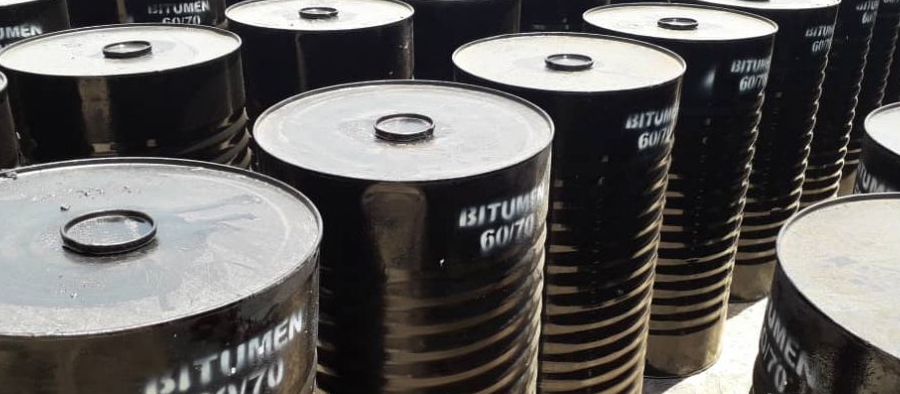
What is Bitumen?
Bitumen is a mixture of dense, sticky, viscous organic liquids, which is mainly composed of polycyclic aromatic hydrocarbons, obtained naturally from crude oil distillation.
Naturally occurring or crude bitumen is a sticky, tar-like form of petroleum which is so thick and heavy that it must be heated or diluted before it can flow.
At room temperature, it is much like cold ooze. Refined Bitumen is the residual (bottom) fraction obtained by fractional distillation of crude oil. It is the heaviest fraction and the one with the highest boiling point of 525 °C (977 °F).
Types of Bitumen
In general, bitumen can be divided into two main categories: petroleum bitumen and natural or mineral bitumen. Petroleum bitumen is a bitumen that is produced in a refinery by the distillation of crude oil. The bitumen itself is divided into several important types.
Blended bitumen, soluble bitumen, leachate or emulsion and modified bitumen are among these categories. In this two-part article, we examine the characteristics of different types of bitumen.
Bitumen production in the refinery has a general approach. The bitumen produced by different processing methods is then converted into petroleum bitumen. At the beginning of this article, we will attempt to describe, in simple terms, the stages of bitumen production and then examine different types.
Bitumen Petroleum production process
The crude oil is heated in a pressure oven at 300 to 350 ° C. Then the heated crude oil enters the distillation tower. In these conditions the inlet of the distillation tower contains liquid and steam. Naturally, a portion of the crude oil that has a boiling point higher than the defined boiling point will be left in the liquid phase, and the remainder having a boiling point below the furnace temperature, enters the distillation tower.
Under these conditions, lighter components such as kerosene, gasoline and gas oil are separated from crude oil, and heavier components leave the distillation tower. In general, the extracted heavy material consists of two main components: bitumen and lubricating oil. So in the second step, bitumen and oil should be separated. At this stage, the furnace temperature is raised to 400 ° C to separate the bitumen and oil.
Other stages of Petroleum bitumen production process
They also reduce the pressure inside the tower to prevent breakdown of molecules and thermal degradation. This helps to reduce the temperature needed for separation. The distillation tower in which this process is carried out is called the atmospheric distillation tower. After heating the materials in the distillation tower to the desired temperature, they enter the vacuum distillation tower.
At this point, from the bottom of the distillation tower upwards, a special water vapor pressure is created. This pressure separates the volatile and light materials and exits them from the upper part of the distillation tower. The main non-volatile material remaining in the distillation tower is the bitumen.
In fact, it is used as a feed in the bitumen manufacture with different grades. The bitumen obtained from the vacuum tower can be used in some cases, but most often the properties of the bitumen need to be improved through processes to be applicable in various industries. In this article, we present the types of bitumen made from this bitumen.
Blown Bitumen
Blown bitumen is the most popular and widely used type of bitumen. This type of bitumen is used in many cases. Blown bitumen is used as a waterproofing insulator, insulating blocks, asphalt, and roof sealing. Actually, this bitumen has various types that are designed according to ASTM standards and each of them has its own characteristics and properties.
The production method of bitumen is relatively simple. The first bitumen was made in 1890 due to the reaction of bitumen heated with oxygen. This has also led to a great deal of research in this field and the scientific method of its manufacture and required equipment.
In the bitumen production, the bitumen is warmed sufficiently, and then the aeration process is initiated by special methods. In this process the bitumen hardens in the air and decreases its sensitivity to heat. It is interesting to know that the same bitumen has different types. Feed type, temperature variables, bitumen viscosity, aeration time, aeration ratio, etc. will all be effective in this regard; and provide bitumen with specific characteristics.
In this section, we present the bitumen production method and introduce some blown bitumen. In the next section we will introduce other types of bitumen.
Types of petroleum bitumen include blown bitumen, soluble bitumen, leachate and modified bitumen. In the first part, you will be introduced the uses and features of blown bitumen. In the second part of this article we will consider other types of bitumen.
Soluble bitumen
In simple terms, dissolved bitumen is obtained by dissolving pure bitumen in solvents or oils. This bitumen is most commonly used in road construction industries and operations for technical and economic reasons. In fact, pure bitumen is all solid and cannot be used in road construction. Soluble bitumen as a special type of petroleum bitumen has different grades and qualities. From the quality of the bitumen used to the type and amount of the solvent, they all affect the final quality of the bitumen.
Naturally, the higher the amount of petroleum solvents in pure bitumen, the more fluid the fluid will be. This percentage typically ranges from 10 to 50 percent.
Heating the bitumen and turning it into a liquid at high temperatures is not logical for a variety of reasons. Bitumen decomposition at high temperatures, contamination, need for on-site heating equipment, tightening after cooling, inability to penetrate porous minerals, possible hazards to workers, financial losses from accidents, etc. are all considered as justification to use this type of bitumen as the best choice for asphalt, and road construction.
Finally, if bitumen is used in humid environments, it is better to have a certain acidic degree to give a better surface adhesion to wet materials.
The bitumen is divided into three groups: premature, slow, and late according to the rate of hardening and the type of solvent.
Bitumen or bitumen emulsion
The leachate is a two-phase mixture; it is made of two immiscible liquids. In this mixture the inner phase is scattered as fine particles inside the outer phase. The particle diameter of the emulsion is between 0.5 and 5 microns, so the particle diameter is larger than the actual solids and colloidal states.
A substance which is called emulsifier also plays a key role. It stabilizes the two-phase mixture produced. In fact without the emulsion, the components of this mixture are immediately separated; and the resulting product will be unstable. In the meanwhile, the emulsion of the instrument stabilizes it.
Emulsions are divided into different categories. In terms of the suspended phase, they are divided into two groups of water-in-oil and oil-in-water; they are divided into three groups of non-ionic, anionic and cationic; they are divided into rapid setting, medium setting and slow setting.
Production of cold asphalt, surface asphalt, single coats, slate coats, and protective coatings for roofs, insulation of roofs and mulching of sand grit are the applications of leachate or bitumen emulsion.
Modified bitumen
Pure bitumen does not have the proper physical and mechanical properties for a variety of reasons. These bitumen have weaknesses in their various functions due to their inherent characteristics.
For example, high sensitivity, low tensile strength, low temperature tolerance range, and so on are all examples of pure bitumen. For this reason, bitumen companies for industrial use are always trying to make bitumen a better, more efficient, and durable material by changing the properties of bitumen. The improved bitumen is called modified bitumen.
Bitumen 60-70
| Test | Test Method | 60-70 |
|---|---|---|
| Density | ASTM D-7 | 06/1-01/1 |
| At penetration of mm / 10, 25C degrees | ASTM D-5 | 60-70 |
| Softening Point ºC | ASTM D-36 | 49-56 |
| Tensile strength at 25 ºC cm | ASTM D-113 | Min 100 |
| Flash point ºC | ASTM D-92 | Min 250 |
| Solubility in disulfide% wt. | ASTM D-4 | 5/99 |
| Stain test | AASHTO T 102 | Negative |
| Weight loss due to heat% wt. | ASTM D-6 | Max 2/0 |
| Effect of diffusion drop on heat,% | ASTM D-6-D-5 | Max 20 |
- Penetration Bitumen (30-40, 40-50, 60-70, 85-100, 80-100)
- Viscosity Grade (VG-10, VG-20, VG-30, VG-40)
- Cutback Bitumen (Rapid-Curing, Medium-Curing, Slow-Curing)
- Emulsion Bitumen (CRS, CMS, CSS)
- Oxidized Bitumen (75/30, 85/25, 85/40, 95/25, 105/35, 115/15)
- Modified Bitumen
Available packings are:
- New steel drum : 150kg, 180kg and 220kg
- Jumbo bag : 1000kg, 500kg and 300kg
For more information on the product grades and data sheet, please feel free to contact us
